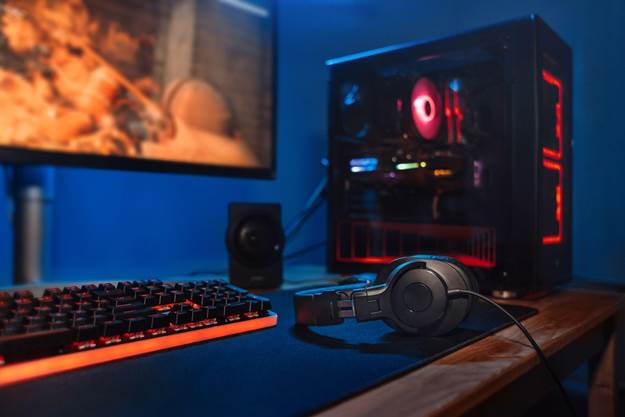Designing a gaming setup means thinking about comfort, function, and style in the same space. In Australia, gamers spend long hours playing at home, so each part of the setup should make those hours more comfortable and enjoyable. Many gamers start by choosing furniture that supports comfort and long sessions. For those interested in better posture, finding a standing desk in Australia can make gaming both healthier and more enjoyable. A well-designed setup helps you stay focused and adds to the overall gaming experience.
Choosing the Right Desk for Gaming
The desk sits at the center of any gaming station. Pick one that fits your room and holds your gear without feeling cramped. Some desks come with cable management features that keep cords neat. Surface space should be wide enough for multiple monitors, a keyboard, and mouse movement. An adjustable desk lets you switch between sitting and standing positions. This variety helps reduce strain during long sessions. A solid desk gives your entire setup a stable foundation and keeps your equipment safe.
Setting Up a Comfortable Gaming Chair
A quality chair supports your back, shoulders, and legs. Look for one with adjustable height and tilt. Armrests help prevent shoulder tension. Lumbar support is important for long stretches at the computer. Some chairs use memory foam or mesh for extra comfort. Test out different options in person if you can, as body shapes and sizes vary. A comfortable chair allows you to stay focused and reduces fatigue.
Monitor Placement and Visual Comfort
Monitor setup plays a big role in gaming comfort. Position your screens at eye level to avoid neck pain. Use monitor arms to adjust angles and height for the best view. Distance from your eyes to the screen should allow you to see everything without leaning forward. Many gamers use two or three monitors, so plan your desk layout with this in mind. Good monitors with high refresh rates and low response times improve game visuals and performance.
Lighting for Focus and Mood
Lighting affects how you feel and play. Try to mix natural and artificial light in the room. Use blinds or curtains to reduce glare during the day. Add a desk lamp with adjustable brightness for evening sessions. LED strips or smart bulbs can create soft background light and add a personal touch. Avoid harsh overhead lights, which cause eye strain. The right lighting keeps you alert and helps set the mood for gaming.
Audio and Headset Considerations
Clear sound helps with in-game awareness and team communication. Some players use speakers, but many prefer a headset for privacy and detail. Look for a headset with soft ear pads and an adjustable headband. A built-in microphone should pick up your voice clearly without background noise. Wired headsets work well for stability, while wireless models allow more freedom of movement. Good audio quality can make the gaming experience much richer.
Cable Management for a Clean Setup
Many devices mean many cords. Good cable management keeps your space tidy and safe. Use cable ties, clips, or sleeves to gather cords along the back or underside of the desk. Store power boards off the floor where possible. Label cords if you often switch equipment. Clean cable runs prevent tripping hazards and make your setup easier to clean. For quality solutions like cable ties, racks, and sleeves, check out 4cabling for reliable cable management products.
Keeping Gear Cool and Organized
Gaming computers and consoles produce heat. Place your PC or console in a spot with airflow around it. Keep vents clear of dust and avoid blocking them with books or decorations. Use shelves or racks to store controllers, games, and accessories. Small storage bins help keep the desktop free of clutter. When gear is organized and cool, it lasts longer and works better.
Internet and Network Setup
A strong internet connection matters for online games. Use a wired Ethernet connection for stable speeds. If you rely on Wi-Fi, place the router nearby and check for interference from walls or other devices. Consider a mesh network if you have a large house. Stable network speeds prevent lag and let you stay connected during group sessions or streaming.
Personal Touches and Comfort
Make the space your own. Add posters, figures, or plants for a look you enjoy. Use a fan or small air conditioner if the room heats up during long sessions. A water bottle on the desk encourages hydration. If you play with friends in the same room, leave space for extra chairs or a second desk. Your setup should support both solo and group gaming.
Reviewing Your Setup Over Time
Needs change as games and gear evolve. Review your setup now and then for comfort and function. Rearrange items or upgrade furniture as needed. Listen to your body for signs of strain. Stretch, walk, or change position during breaks. With small adjustments, your gaming area can keep up with both new tech and your personal preferences.
Final Thoughts
A strong gaming setup brings together the right desk, chair, monitors, lighting, and accessories for comfort and performance. Each choice matters, from cable management to personal style. A balanced environment helps you focus on the game and supports your well-being at the same time. With care and planning, your Australian gaming space can be both flexible and rewarding for many hours of play.

Hi! I’m Bryan, and I’m a passionate & expert writer with more than five years of experience. I have written about various topics such as product descriptions, travel, cryptocurrencies, and online gaming in my writing journey.




![‘Jay Kelly’ Review – Noah Baumbach Makes A Case For The Magic Of Movie Stardom [NYFF 2025] ‘Jay Kelly’ Review – Noah Baumbach Makes A Case For The Magic Of Movie Stardom [NYFF 2025]](https://cdn.geekvibesnation.com/wp-media-folder-geek-vibes-nation/wp-content/uploads/2025/11/Jay-Kelly-JKELLY_20240523_15320_C2_R-300x180.jpg)

